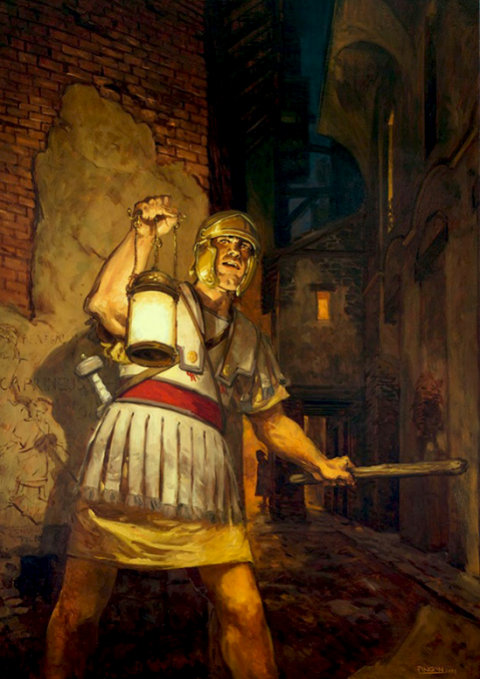Two literary sources speak of the barracks of the vigiles in Rome. In Roman civil law (Corpus iuris civilis, I,15,3) is a text from the Severan period by the jurist Paulus, from his book "On the Duties of the Prefect of the Night Watch": "Augustus stationed seven cohorts at suitable locations, so that each cohort protected two urban districts. Tribunes were placed at the head, and above all of them a highly regarded man called the 'nightwatch commander'." (Augustus septem cohortes opportunis locis constituit, ut binas regiones urbis unaquaeque cohors tueatur, praepositis eis tribunis et super omnes spectabili viro qui praefectus vigilum appellatur). More information is provided by the so-called regionary catalogues from late antiquity, the Notitia regionum urbis Romae from the middle of the fourth century, and the Curiosum urbis Romae regionum XIV from the second half of the fourth century. Both mention the presence of a cohort (for example: "the sixth cohort of the watchmen", cohortem VI vigilum) in seven regions: cohort V in region II, II in IV, III in VI, I in VII, VI in VIII, IV in XII, and VII in XIV. In the summary (breviarium) of the Notitia we read: "7 cohorts of watchmen using 14 guardhouses" (cohortes vigilum VII quorum excubitoria XIV). Obviously there was an excubitorium, a guardhouse, in each of the 14 regions, and a main guardhouse in 7 regions. The assignment of the second region to each cohort is disputed, and may even have changed in the course of time.
Several scholars have tried to fix the location of the guardhouses, using the regionary catalogues, excavated remains, the place of discovery of inscriptions and the famous marble plan of Rome (forma urbis Romae).
Cohort I in region VII
This guardhouse has been placed between the church of San Marcello and the Basilica dei Santi Dodici Apostoli. Rodolfo Lanciani informs us that a report from 1644 mentions "huge halls, ornamented with columns, pedestals, statues, marble incrustations, and mosaic pavements; waiting-rooms and offices, having marble seats around the walls, which were covered with finely designed frescoes; statues raised to gods and emperors in the vestibule and in the atrium of the barracks, that represented the Genius cohortis primae vigilum, Caracalla, Gordianus Pius, Furia Sabinia Tranquillina (his empress), Constantine, Constans, Valentinian, and Gratianus".
Cohort II in region IV
Inscriptions point to the area of Santa Bibiana, next to Stazione Termini. In the 16th century Pirro Ligorio mentions the destruction of what might have been the guardhouse.

Santa Bibiana. Photo: Wikimedia Commons, Sailko.
Cohort III in region VI
This guardhouse must have been to the south of the Baths of Diocletian. Several inscriptions of the vigiles have been found in the region, but these do not allow a more specific localisation.
Cohort IV in region XII
Inscriptions point to the area of San Saba.
Cohort V in region II
Two inscriptions, both mentioning the protective spirit of a century, the Genius Centuriae, suggest the presence of a guardhouse below and next to Santa Maria in Domnica. Part of the building may have been excavated: a courtyard and a porticus.
Cohort VI in region VIII
The regionary catalogues place this guardhouse near Trajan's Forum.
Cohort VII in region XIV
In Trastevere part of a building was excavated in which many graffiti of vigiles were found. One of these also mentions a protective spirit, a Genius. We discuss this building on a separate page.
The headquarters of the Praefectus Vigilum
It would make sense if the prefect of the vigiles had a separate office. About the location however nothing is known. There has been speculation about the area of the Crypta Balbi, near Largo di Torre Argentina.

|
Distribution map of the evidence for the guardhouses of the vigiles in Rome.
Sablayrolles 1996, fig. 1.
Each cohort had a main building in one of the two regions it supervised. Here we expect to find the office of the tribune and the archives. Scholars have debated the question whether the vigiles used 21 buildings, namely 14 excubitoria plus 7 main buildings, or 14, namely 14 excubitoria, 7 of which were also the main building. The latter solution is to be preferred, because it would be awkward if the catalogues mention secondary buildings only.
 |
 |
| Vigiles at work. Images: romanoimpero.com. | |